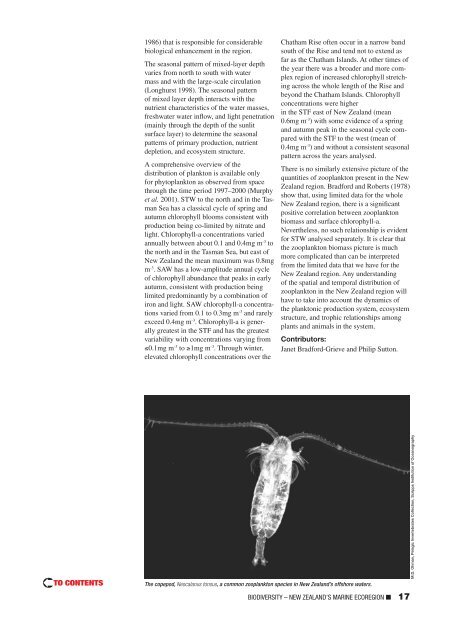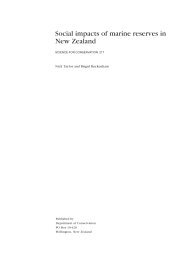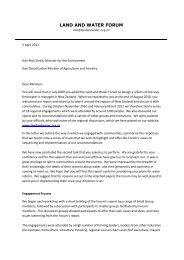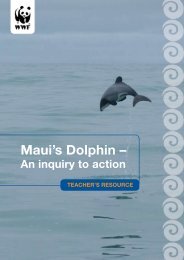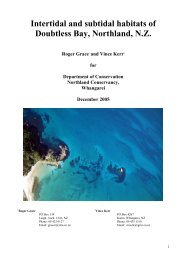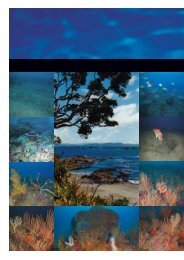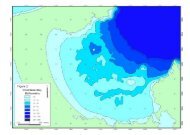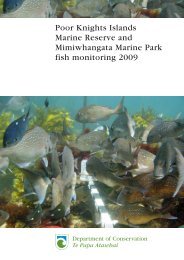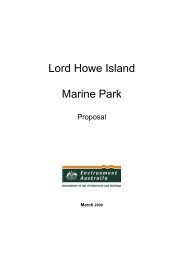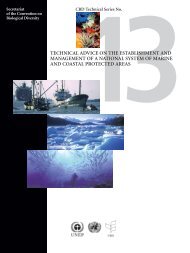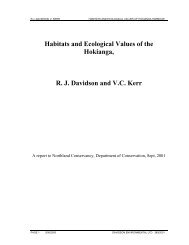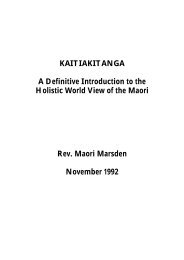WWF Shining a spotlight on the biodiversity of ... - MarineNZ.org.nz
WWF Shining a spotlight on the biodiversity of ... - MarineNZ.org.nz
WWF Shining a spotlight on the biodiversity of ... - MarineNZ.org.nz
You also want an ePaper? Increase the reach of your titles
YUMPU automatically turns print PDFs into web optimized ePapers that Google loves.
1986) that is resp<strong>on</strong>sible for c<strong>on</strong>siderable<br />
biological enhancement in <strong>the</strong> regi<strong>on</strong>.<br />
The seas<strong>on</strong>al pattern <strong>of</strong> mixed-layer depth<br />
varies from north to south with water<br />
mass and with <strong>the</strong> large-scale circulati<strong>on</strong><br />
(L<strong>on</strong>ghurst 1998). The seas<strong>on</strong>al pattern<br />
<strong>of</strong> mixed layer depth interacts with <strong>the</strong><br />
nutrient characteristics <strong>of</strong> <strong>the</strong> water masses,<br />
freshwater water inflow, and light penetrati<strong>on</strong><br />
(mainly through <strong>the</strong> depth <strong>of</strong> <strong>the</strong> sunlit<br />
surface layer) to determine <strong>the</strong> seas<strong>on</strong>al<br />
patterns <strong>of</strong> primary producti<strong>on</strong>, nutrient<br />
depleti<strong>on</strong>, and ecosystem structure.<br />
A comprehensive overview <strong>of</strong> <strong>the</strong><br />
distributi<strong>on</strong> <strong>of</strong> plankt<strong>on</strong> is available <strong>on</strong>ly<br />
for phytoplankt<strong>on</strong> as observed from space<br />
through <strong>the</strong> time period 1997–2000 (Murphy<br />
et al. 2001). STW to <strong>the</strong> north and in <strong>the</strong> Tasman<br />
Sea has a classical cycle <strong>of</strong> spring and<br />
autumn chlorophyll blooms c<strong>on</strong>sistent with<br />
producti<strong>on</strong> being co-limited by nitrate and<br />
light. Chlorophyll-a c<strong>on</strong>centrati<strong>on</strong>s varied<br />
annually between about 0.1 and 0.4mg m -3 to<br />
<strong>the</strong> north and in <strong>the</strong> Tasman Sea, but east <strong>of</strong><br />
New Zealand <strong>the</strong> mean maximum was 0.8mg<br />
m -3 . SAW has a low-amplitude annual cycle<br />
<strong>of</strong> chlorophyll abundance that peaks in early<br />
autumn, c<strong>on</strong>sistent with producti<strong>on</strong> being<br />
limited predominantly by a combinati<strong>on</strong> <strong>of</strong><br />
ir<strong>on</strong> and light. SAW chlorophyll-a c<strong>on</strong>centrati<strong>on</strong>s<br />
varied from 0.1 to 0.3mg m -3 and rarely<br />
exceed 0.4mg m -3 . Chlorophyll-a is generally<br />
greatest in <strong>the</strong> STF and has <strong>the</strong> greatest<br />
variability with c<strong>on</strong>centrati<strong>on</strong>s varying from<br />
≤0.1mg m -3 to ≥1mg m -3 . Through winter,<br />
elevated chlorophyll c<strong>on</strong>centrati<strong>on</strong>s over <strong>the</strong><br />
Chatham Rise <strong>of</strong>ten occur in a narrow band<br />
south <strong>of</strong> <strong>the</strong> Rise and tend not to extend as<br />
far as <strong>the</strong> Chatham Islands. At o<strong>the</strong>r times <strong>of</strong><br />
<strong>the</strong> year <strong>the</strong>re was a broader and more complex<br />
regi<strong>on</strong> <strong>of</strong> increased chlorophyll stretching<br />
across <strong>the</strong> whole length <strong>of</strong> <strong>the</strong> Rise and<br />
bey<strong>on</strong>d <strong>the</strong> Chatham Islands. Chlorophyll<br />
c<strong>on</strong>centrati<strong>on</strong>s were higher<br />
in <strong>the</strong> STF east <strong>of</strong> New Zealand (mean<br />
0.6mg m -3 ) with some evidence <strong>of</strong> a spring<br />
and autumn peak in <strong>the</strong> seas<strong>on</strong>al cycle compared<br />
with <strong>the</strong> STF to <strong>the</strong> west (mean <strong>of</strong><br />
0.4mg m -3 ) and without a c<strong>on</strong>sistent seas<strong>on</strong>al<br />
pattern across <strong>the</strong> years analysed.<br />
There is no similarly extensive picture <strong>of</strong> <strong>the</strong><br />
quantities <strong>of</strong> zooplankt<strong>on</strong> present in <strong>the</strong> New<br />
Zealand regi<strong>on</strong>. Bradford and Roberts (1978)<br />
show that, using limited data for <strong>the</strong> whole<br />
New Zealand regi<strong>on</strong>, <strong>the</strong>re is a significant<br />
positive correlati<strong>on</strong> between zooplankt<strong>on</strong><br />
biomass and surface chlorophyll-a.<br />
Never<strong>the</strong>less, no such relati<strong>on</strong>ship is evident<br />
for STW analysed separately. It is clear that<br />
<strong>the</strong> zooplankt<strong>on</strong> biomass picture is much<br />
more complicated than can be interpreted<br />
from <strong>the</strong> limited data that we have for <strong>the</strong><br />
New Zealand regi<strong>on</strong>. Any understanding<br />
<strong>of</strong> <strong>the</strong> spatial and temporal distributi<strong>on</strong> <strong>of</strong><br />
zooplankt<strong>on</strong> in <strong>the</strong> New Zealand regi<strong>on</strong> will<br />
have to take into account <strong>the</strong> dynamics <strong>of</strong><br />
<strong>the</strong> plankt<strong>on</strong>ic producti<strong>on</strong> system, ecosystem<br />
structure, and trophic relati<strong>on</strong>ships am<strong>on</strong>g<br />
plants and animals in <strong>the</strong> system.<br />
C<strong>on</strong>tributors:<br />
Janet Bradford-Grieve and Philip Sutt<strong>on</strong>.<br />
The copepod, Neocalanus t<strong>on</strong>sus, a comm<strong>on</strong> zooplankt<strong>on</strong> species in New Zealand’s <strong>of</strong>fshore waters.<br />
BIODIVERSITY – NEW ZEALAND’S MARINE ECOREGION ■ 17<br />
M.D. Ohman, Pelagic Invertebrates Collecti<strong>on</strong>, Scripps Instituti<strong>on</strong> <strong>of</strong> Oceanography


